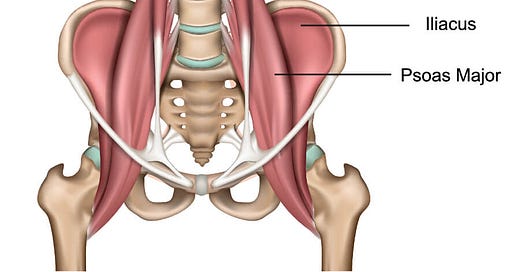Release Your Psoas and Free Your Lower Back
Discover how this deeply important muscle is holding your postural patterns and how to reset them regularly using only a tennis ball.
The Psoas muscle—often referred to as the “hidden core”—is a powerful muscle that many of us don't even realize is the culprit for so much of our pains. But what exactly is the Psoas, and why is it so crucial to our overall well-being?
While there is a PLETHORA of studies and theories about the somatic and emotional holding patterns in your psoas, each person’s emotional holding patterns are so unique and personal, that I’m here to talk about the physical holding patterns that apply to us all. Your Psoas is the most intrinsic hip flexor muscle, which plays a pivotal role in connecting the upper body to the lower body. It's part of your deep core and attaches to the lower spine, extending down through the pelvis to the femur bone. Just think about that for a moment: this muscle is simultaneously a hip, back, and core muscle. It influences your posture, stability, and even your breathing.
So, when is the Psoas muscle at its tightest? When you’re sitting. And then after you’re sitting are you like, CYCLING?! In today's world, where many of us are glued to our desks or seated for long periods, the Psoas remains in a shortened, contracted state. This prolonged sitting creates a chain reaction in the body. When you finally stand up, your Psoas doesn't always stretch out entirely; instead, it stays partially contracted, which can lead to various issues such as hip flexor and lower back pain. This tightness also inhibits the full engagement of your core muscles and can contribute to pelvic floor dysfunction.
But there's good news: You can release your own Psoas with a simple, sensational and super effective technique. Before we dive into that, let’s understand a bit more about the area we're focusing on.
The Psoas is often grouped with the Iliacus, another important muscle that lines the inside of your pelvis. Together, these muscles form the Iliopsoas, which is responsible for hip flexion and plays a major role in maintaining balance, pelic floor support and proper alignment of your spine. The section of the Psoas we're going to target today is where the Psoas Major and Iliacus meet—this is a sweet spot for releasing tension and unlocking mobility in your hips and lower back.
Now, grab a tennis ball and get ready to explore this area with me. You might be surprised at how much tension you’re holding there—and how good it feels to release it.
Step-by-Step Psoas Release Technique
Locate the Spot: Lie down on your back with your knees bent and feet flat on the floor. Find the bony protrusion on the front of your hip (this is your ASIS). From there, move slightly inward and downward toward your belly button. This is where the Psoas Major and Iliacus meet.
Position the Tennis Ball: Place the tennis ball directly over that area. Gently press down, allowing your body weight to sink into the ball. You should feel a deep, somewhat uncomfortable pressure—not pain, but a “good hurt.”
Breathe and Relax: Breathe deeply, and as you exhale, allow your body to relax into the ball. You might feel the muscle slowly releasing, or you might feel a pulsating sensation—this is normal.
Move and Explore: Once you’ve settled into the pressure, you can start to make small movements with your hip, rocking side to side or up and down. This helps to further release the tension in the muscle.
Hold for a Minute or Two: Continue to apply pressure for about 60-90 seconds, or until you feel a significant release in the muscle. Be patient—sometimes, the Psoas takes a little while to fully relax.
Why This Matters
Releasing the Psoas can have a profound impact on your overall body mechanics. By relaxing and awakening this muscle, you allow your pelvis to realign, which can ease tension in the lower back, improve hip mobility, and activate your core and pelvic floor muscles more effectively. It’s a simple, yet powerful technique that can bring immediate relief and lasting benefits.
Now, go ahead and try this technique—feel the difference it makes in your body. Whether you're looking to ease discomfort, enhance your athletic performance, or simply move with more freedom, releasing your Psoas could be the missing piece in your routine.
Join the Conversation
I’d love to hear about your experience! Share your before and after stories in the comments or tag me on social media. Let’s connect and celebrate the freedom that comes from taking care of our bodies, one muscle at a time.
See you in two weeks!
Love,
Maggie





